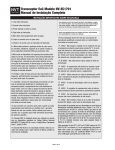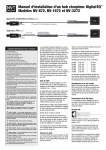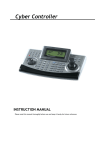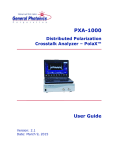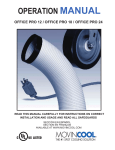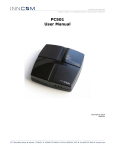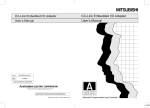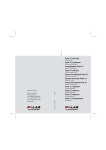Download Model NV-EC1701 EoC Ethernet over Coax
Transcript
Model NV-EC1701 EoC Ethernet over Coax Transceiver Complete Installation Guide with PoE, PoE+, or High Power PoE IMPORTANT SAFETY INSTRUCTIONS 1) Read these instructions. WARNING: TO REDUCE THE RISK OF ELECTRICAL SHOCK, DO NOT EXPOSE THIS APPARATUS TO RAIN OR MOISTURE. 2) Keep these instructions. This installation should be made by a qualified service person and should conform to all local codes. 3) Heed all warnings. 4) Follow all instructions. 5) Do not use this apparatus near water. 6) Clean only with a dry cloth. 7) Install in accordance with the manufacturer’s instructions. 8) Do not install near any heat sources such as radiators, heat registers, stoves or other apparatus (including DVRs) that produce heat. 9) Do not defeat the safety purpose of the polarized or grounding-type plug. A polarized plug has two blades with one wider than the other. A grounding type plug has two blades and a third grounding prong. The wider blade or the third prong are provided for your safety. If the provided plug does not fit into your outlet, consult an electrician for replacement of the obsolete outlet. 10) Protect the power cord from being walked on or pinched particularly at plugs, convenience receptacles, and the point where they exit from the apparatus. 11) Only use attachments/accessories specified by the manufacturer. 12) Refer all servicing to qualified service personnel. Servicing is required when the apparatus has been damaged in any way, such as a power supply cord or plug is damaged, liquid has been spilled, or objects have fallen into the apparatus, the apparatus has been exposed to rain or moisture, does not operate normally, or has been dropped. This installation should be made by a qualified service person and should conform to all local codes. 13) BNC Connection: the installation shall be in accordance with the applicable provisions of the National Electrical Code ANSI/NFPA 70, Article 800.90 and Canadial Electrical Code Part 1, Section 60-504. 14) RJ45 PoE connection: to be connected only to networks or circuits that are not routed to outside plant or building. TO REDUCE THE RISK OF ELECTRICAL SHOCK, DO NOT REMOVE COVER OR BACK. NO USER SERVICEABLE PARTS INSIDE. REFER SERVICING TO QUALIFIED SERVICE PERSONNEL. Page 1 of 14 WARNING - Do not install the unit in an environment where the operating ambient temperature exceeds 185° F (85° C). The ventilation should not be impeded by covering the unit with items, such as newspapers, table-cloths, curtains, etc. No naked flame sources, such as lighted candles should be placed on the apparatus. WARNING - Do not interconnect multiple outputs. Never use more than two power supplies within a network system. WARNING - The apparatus shall not be exposed to dripping or splashing and no objects filled with liquids, such as vases, shall be placed on the apparatus. WARNING - Use only a Certified power cord and plug (coupler / mains) assemblies for location installed. WARNING - Power cord is regarded as main disconnect. WARNING - The appliance coupler (power cord/mains) shall remain readily operable. WARNING - For safety, never put NVT signals in the same conduit as high-voltage wiring. This product is intended to be supplied by a certified power source marked “Class 2” or “LPS” and rated 48-56 VDC, minimum 840mA, which may or may not be provided with the product. Power supplies, when provided, are external inline, with an IEC380C14 power inlet and 6 ft (1.8 m) line-cord. Input Voltage is 100 ~240 VAC 50-60 Hz. A molded P1J 5.5 mm barrel connector provides a Class 2 (SELV) 48-56 VDC regulated output. Line cord UL approved type SPT-2, SVT, or SJT, 18/3 AWG Min. 300VAC, 60° C Max. 15ft (4.5m) long. One end with IEC380-C13 appliance coupler and the other end with NEMA 1015P or equivalent for country. Model NV-EC1701 EoC Ethernet over Coax Transceiver with PoE, PoE+, or High Power PoE PRODUCT OVERVIEW Features: • Transmit 10/100 BaseT Full Duplex Ethernet up to 8,000ft (2,500m) or more over RG-59* • Powers PoE entry stations (or other PoE, PoE+, or High Power devices), up to 60 watts * • 48 or 56 VDC is distributed over the coax to all connected equipment. Powers PoE, PoE+, or High Power PoE cameras (or other PoE devices), up to 60 watts* • One EoC transceiver at the network-end can support multiple remote transceivers/IP cameras using the NV-EC4BNC adaptor/splitter • Up to four transceivers can be rack mounted on an NV-RMEC16 Rack Mount Tray Kit, connecting up to 16 cameras • Easy configuration, no PC required • Transparently supports all networking protocols (UDP, TCP/IP, HTTP, Multicast etc.) • Advanced 128-bit AES encrypted transmission and PoE+ power technology • Built-in transient protection; Industrial temperature range • Available in 1-4 Camera System Kits • Limited lifetime warranty The NVT Model NV-EC1701 Ethernet over Coax EoC Transceiver is a compact media converter that allows 10/100 BaseT Ethernet and PoE+ power to be transmitted using coax cable. These devices are often used in legacy installations where existing cable is re-deployed as part of an upgrade to IP cameras. 48 or 56 VDC class 2 power is delivered to one transceiver, which distributes it to up to four remote transceivers, and their PoE or PoE+ or High Power PoE cameras*. These transceivers are extremely simple to use, with no IP or MAC addressing required. Status LEDs indicate power and link connectivity/activity for RJ45 and BNC ports. They are backed by NVT’s award winning customer support and limited lifetime warranty. *Distance and number of devices supported will often be lower due to power delivery voltage-drop on the wire. See Wire Distance Chart on pages 8 & 9. Page 2 of 14 CONFIGURATION INSTRUCTIONS NV-EC1701 EoC transceivers transmit high bandwidth encrypted Ethernet signals over conventional coax cables. To provide utmost signal integrity and security, the NV-EC1701 transceivers must be configured to communicate exclusively with other transceivers within their Network Group. This group typically consists of one NV-EC1701 located at the control room (usually connected to an ethernet switch or router), and up to four remote NV-EC1701 transceivers (usually connected to IP cameras). Before connecting to the network, each NV-EC1701 must learn which other NV-EC1701 transceivers are to be part of that group. This simple process is called Joining. It is recommended that transceivers in each Network Group be configured prior to deployment using these instructions: Step One: Gather Materials • NV-EC1701 transceivers • 48VDC power supply & line-cord (NV-PS48-60W) • Coax jumper • Small paper-clip, partially straightened • Device labels • IP Network Documentation Log Step One: Gather Materials Step Two: Connect Hardware • Remove and discard the “Configure Before Use” labels. • Connect two NV-EC1701 transceivers using a coax jumper. • Connect a 48-56V power supply to transceiver #1; Apply power. Step Two: Remove • Verify that the blue POWER LED on each transceiver illuminates. • After 20 seconds, verify that the green BNC LED on each transceiver is off. If a BNC LED is on, the transceiver has been previously joined. Perform the un-joining process below before proceeding. Label Connect Hardware Step Three: Joining • On transceiver #1, using the straightened paper-clip, momentarily depress the small push-button located behind and slightly above the RJ45 LED. The blue Power LED will begin blinking. • Depress the same push-button on the transceiver #2. • Both transceivers have now entered Join Mode.They will find each other and establish encrypted communication. In about 10 seconds, the blue Power LEDs on both transceivers will return to a steady on condition, indicating a successful Join. Step Four: Adding Transceivers (if required) • Disconnect transceiver #2 and replace it with a new un-joined transceiver (#3, or #4, or #5). • Repeat steps two and three to add additional transceivers to the same Network Group. Step Five: Documentation • Label the configured transceivers with a unique Network Group ID of your choice. This will help you identify them after they have been deployed. • Record this Network Group information in your IP Network Documentation Log. This log may include essential documentation which will help you identify all system devices during and after deployment: • Camera Number • Camera-end NVT Transceiver MAC Address • Camera Position/Location • NVT Transceiver Network Group Name • Camera Make & Model • Control Room NVT Transceiver MAC Address • Camera MAC & IP Address • Control Room Router Port Number • Camera Login & Password Un-Joining a Transceiver If you need to move a transceiver from one Network Group to another, it must first un-learn its previous Network Group and be returned to an un-joined state. Do this by: • Connect a 48-56 VDC power supply to a transceiver to be un-joined. • Wait until its green BNC LED is lit. • Using the straightened paper-clip, momentarily depress the small push-button located behind and slightly above the RJ45 LED until the green BNC LED goes off. The RJ45 LED should remain off. • Release the paperclip. • Observe that the BNC and RJ45 LEDs flash. • Observe that the BNC and RJ45 LEDs turn off. • Observe that the BNC goes on solid. • Un-joining is now complete. If you are not sure that un-joining has been successful, remove and then re-apply power, and repeat. Page 3 of 13 Step Three: Transparent view of push-button location Step Five: Transceiver MAC address Model NV-EC1701 EoC Ethernet over Coax Transceiver with PoE, PoE+, or High Power PoE INSTALLATION INSTRUCTIONS Model NV-EC1701 RG 59/U 20AWG Monitor NV-EC1701 Cat5 Ethernet over Coax Transceiver Hybrid DVR or NVR DVR / NVR ≤328ft (≤100m) Ethernet over Coax Transceiver NV-EC1701 Model NV-EC1701 IP Camera Cat5 ≤328ft (≤100m) www.nvt.com ● (+1) 650.462.8100 ● (+44) (0) 208 977 6614 6 Watt www.nvt.com ● (+1) 650.462.8100 ● (+44) (0) 208 977 6614 ≤ 1,850 ft (560 m) with a 48V power supply ≤ 4,800 ft (1,4600 m) with a 56V power supply See wire distance charts on pages 8 & 9 or IP Distance Calculator available from www.nvt.com 48VDC Power Supply LAN / WAN Figure 1 - Typical Installation Most installations that use the NV-EC1701 transceiver involve the replacement of an analog camera with an IP camera, while reusing the installed coax cable. Since most IP cameras support PoE (Power over Ethernet), the legacy 24VAC distribution may no longer be needed. Connect an RJ45 patch-cord between the RJ45 jack on the NV-EC1701 and either: 1) an IP camera video input on a Hybrid DVR, or 2) an Ethernet switch allocated for video. See “Hybrid DVR Considerations” on page 5, or “NVR Considerations” on page 6. Disconnect all analog equipment from the coax before installing the IP equipment. The NV-EC1701 uses the coax to deliver 48 or 56VDC. To prevent damage, never connect analog cameras or analog control-room equipment to an NV-EC1701. The Green LEDs will illuminate when a network link is established, and will blink when data traffic is present. Transceiver Configuration NVT EoC transceivers must be configured to communicate exclusively with other transceivers within their Network Group. The configuration process is described on page 3. Connecting the Camera End Install the new IP camera. Mount the NV-EC1701 nearby. Connect an RJ45 patch cable between the network connector (PoE) of the camera and the RJ45 jack on the NV-EC1701. Connect the coax to the BNC jack on the NV-EC1701. For most installations, the IP camera power will be low enough, and the coax distance short enough, so that the IP camera and its NV-EC1701 can receive power through the coax. In most cases, a power supply will not be needed at this end. For additional details, see “High Power Extended Distance Considerations” on page 7. Connecting the Control-room End Install a second NV-EC1701 at the control-room end of the coax cable. If rack-mounting is desired, use the NV-RMEC16 tray, which supports up to four NV-EC1701 transceivers, which together can support up to 16 cameras. Connect the coax cable to the BNC jack on the NV-EC1701. Connect a class 2 (SELV) 48V or 56VDC power supply to the power jack on the NV-EC1701. This will provide power to the entire system, including the cameras. The Blue “Power” LEDs will illuminate on both transceivers. MULTIPLE CAMERAS The NV-EC1701 communicates via the coax using a bus-architecture. This means that up to four remote camera-end NV-EC1701s may be connected together to a fifth NV-EC1701 at the control-room. The coax cables are connected NV-BNCT together using BNC splitters, available from NVT, or elsewhere. If you purchase BNC “T” connectors from another supplier, please purchase high quality connectors. Low cost connectors have been found to have intermittent shield connections. Multiple IP cameras draw more current. To ensure adequate power, see “High Power Extended Distance Considerations” on page 7. NV-EC4BNCT PoE CONSIDERATIONS The NV-EC1701 transceiver has been recently updated to support full PoE, PoE+, or High-Power cameras, as well as nonpowered legacy devices. Unlike conventional PoE, voltage-drop and load current must be confirmed by the installer. See “High Power Extended Distance Considerations” on page 7. NVT’s Class 2 current limiting ensures safety of the installation during fault conditions, while delivering higher power (up to 90 watts) with more efficient allocation amongst loads. Up to two power supplies may be used within a network group. Page 4 of 14 Model NV-EC1701 EoC Ethernet over Coax Transceiver with PoE, PoE+, or High Power PoE HYBRID DVR CONSIDERATIONS Hybrid DVR Coax Model NV-EC1701 Ethernet over Coax Transceiver RG 59/U 20 AWG NV-EC1701 Cat5 ≤328ft (≤100m) Ethernet over Coax Transceiver IP Camera Cat5 ≤328ft (≤100m) Model NV-EC1701 NV-EC1701 6 Watt BNC BNC BNC BNC BNC BNC BNC BNC www.nvt.com ● (+1) 650.462.8100 ● (+44) (0) 208 977 6614 Analog Camera www.nvt.com ● (+1) 650.462.8100 ● (+44) (0) 208 977 6614 ≤ 1,850 ft (560 m) with a 48V power supply ≤ 4,800 ft (1,460 m) with a 56V power supply Monitor DVR / NVR Analog Camera Ports LAN / WAN LAN Port RJ45 IP Camera Port Firewall Power Supply Figure 2 - Hybrid DVR Installation TRANSCEIVER-TO-TRANSCEIVER HYBRID DVR ARCHITECTURE The NV-EC1701 transceivers provide transparent end-to-end 10baseT or 100-BaseT connectivity with auto detection and autocrossover. This means that IP cameras or other devices may be installed at one end, and their data is transparently delivered to the other end. Before installing, transceivers must be configured per the instructions on page 3. The NV-EC1701 is network transparent, and operates in virtually every network environment, including support for Hybrid DVRs. These DVRs have some BNC ports for analog cameras, and some RJ45 ports for IP cameras. The RJ45 “video in” port is the connection point for the NV-EC1701. See figure 2. Long coax distances are supported, although local power may be required for extended distances. See pages 7 - 9. The NV-EC1701 supports TCP/IP, UDP, HTTP, Multi-cast, and other standard protocols. This allows for the transmission of other network traffic besides streaming video. By deploying a Hybrid DVR, with its dedicated IP camera port(s), the network is robust and secure, with none of the traffic, hacking, or virus vulnerabilities associated with PC-like hardware on an open LAN. Depending on the Hybrid DVR, more than one camera may be connected to its IP camera port. Check the Hybrid DVR manual for details. Page 5 of 14 Model NV-EC1701 EoC Ethernet over Coax Transceiver with PoE, PoE+, or High Power PoE NVR CONSIDERATIONS Ethernet Switch Cat5 ≤328ft (≤100m) IP Camera NV-EC1701 RG-59/U 20 AWG LAN / WAN NV-EC1701 Cat5 Ethernet over Coax Transceiver Model NV-EC1701 Model NV-EC1701 IP Camera Cat5 ≤328ft (≤100m) Network Video Recorder www.nvt.com ● (+1) 650.462.8100 ● (+44) (0) 208 977 6614 6 Watt PoE Cat5 ≤328ft (≤100m) Ethernet over Coax Transceiver www.nvt.com ● (+1) 650.462.8100 ● (+44) (0) 208 977 6614 Firewall ≤328ft (≤100m) ≤1,540ft (470m) with a 48V power supply ≤4,550ft (1,388m) with a 56V power supply Power Supply Figure 3 - NVR Installation TRANSCEIVER-TO-TRANSCEIVER NETWORK ARCHITECTURE The NV-EC1701 transceivers provide transparent end-to-end 10-baseT or 100-BaseT connectivity with auto detection and auto-crossover. This means that IP cameras or other devices may be installed at one end, and their data is transparently delivered to the other end. Please read configuration instructions on page 3 before installing. For IP-based CCTV applications, there are some network configurations that are robust, and others that are not recommended. In general, it is best to deploy a separate LAN exclusively for video traffic. Long coax distances are supported, although local power may be required for extended distances. See pages 7 - 9. Although it is possible to place IP cameras onto the end-user’s “Enterprise LAN”, there are several disadvantages in doing so. These include: The NV-EC1701 supports TCP/IP, UDP, HTTP, Multi-cast, and other standard protocols. This allows for the transmission of other network traffic besides streaming video. Traffic Management Considerations When sharing the resources of a LAN, the nature of the traffic must be well understood for it to operate efficiently. For most end-users, the business use of their LAN is constantly changing, critical for their day-to-day operations, and not managed by the same group that manages their security. IP video can often consume large amounts of bandwidth, which may or may not be compatible with existing IT traffic. Security Considerations Most surveillance systems are installed specifically to protect against breaches in security. A shared LAN provides potential opportunities for unauthorized access to security assets. Sniffing IP addresses can result in the unintended disclosure of IP cameras or network vulnerabilities. Spoofing IP addresses could result in the disruption of recording. If you must pass IP camera video through “public” LANs, ensure that video is recorded prior to leaving the secure LAN. Then encrypt it by using a Virtual Private Network (VPN) so that neither the video, nor its addressing is readable on the LAN. Many lowcost routers support VPNs. Page 6 of 14 Model NV-EC1701 EoC Ethernet over Coax Transceiver with PoE, PoE+, or High Power PoE HIGH POWER EXTENDED DISTANCE CONSIDERATIONS NV-EC1701 50 Watt IP Camera, Door Access, or other IP device Cat5 ≤ 285ft (≤ 85m) Model NV-EC1701 Ethernet over Coax Transceiver www.nvt.com ● (+1) 650.462.8100 ● (+44) (0) 208 977 6614 NV-EC1701 Cat5 ≤328ft (≤100m) NVR LAN / WAN Ethernet over Coax Transceiver Model NV-EC1701 NV-EC1701 50 Watt IP Camera, Door Access, or other IP device BNC “T” www.nvt.com ● (+1) 650.462.8100 ● (+44) (0) 208 977 6614 Power Supply Cat5 ≤ 285ft (≤ 85m) Model NV-EC1701 Ethernet over Coax Transceiver www.nvt.com ● (+1) 650.462.8100 ● (+44) (0) 208 977 6614 Power Supply ≤ 5,500ft (1,800m) RG59/U 20 AWG See Wire Distance Chart on page 9 or IP Distance Calculator at www.nvt.com Figure 4 - Alternate Power Supply Location The NV-EC1701 has a power inlet connector that receives 48 or 56 volts from an external Class 2 SELV desk-style power supply. Power is distributed to: 1) the transceiver’s internal electronics; 2) the RJ45, provided the connected camera or other device provides the appropriate 27K ohm PoE ‘discovery signature’. +48V (or +56V) power is provided on pins 1&2 and 5&4, while 3&6 and 7&8 are at 0 V. The use of all four wire-pairs ensures maximum distance, even for high-power loads, such as P/T/Z cameras. 3) the coax cable, where it is used by the control-room NV-EC1701. For fault/safety, never use more than two power supplies within a network. Page 7 of 13 Model NV-EC1701 EoC Ethernet over Coax Transceiver with PoE, PoE+, or High Power PoE WIRE DISTANCE CHARTS The distance capability of wire is dependant on its ability to deliver DC power, and separately, to deliver high-frequency data signals. The graph below shows maximum power delivery when using a 48V power supply. If you are using a 56V power supply, your distances will be 2.6 times those shown in figure 4. If you are not delivering power to your camera (or other remote device), then this graph does not apply. Figure 5 shows the maximum network data rate. A Distance Calculator can be found at www.nvt.com. PoE devices require a minimum of 43V to operate. With a 48V supply, we have 5V of allowable voltage drop on the wire. With a 56V supply, we have 13V of allowable voltage drop on the wire. The voltage will dip in proportion to the remote (camera) load. The graph below shows what distances are supported for various loads and wire types. ● Start with the camera wattage at the left. Sometimes IP cameras are listed as to their PoE Class rather than wattage. If this is the case, use the colored classes instead. ● Now read over to the right until you find your kind of wire. Then look up (feet) or down (meters) to find your maximum wire distance. ● If your wire is not among the examples, simply measure its total resistance and find that value on the right side of the graph. The maximum supported wattage is on the left. 16,400 ft 9,840 ft 8,200 ft 6,560 ft 5,904 ft 4,920 ft 3,936 ft 3,280 ft 2,624 ft 1,968 ft 1,640 ft 1,312 ft 984 ft 820 ft 656 ft 590 ft 492 ft 397 ft 328 ft 262 ft 197 ft 164 ft 131 ft 98 ft 82 ft 66 ft 59 ft 49 ft 40 ft 33 ft 13,120 ft Wire Distance 30 25 20 18 15 6Ω 7Ω 9Ω 5 RG 9/U 11 Ω G AW G AW 23 12 W 10 W 14 W W W W W 11 RG 4Ω G AW 18 6 G RG AW 20 /U WG 59 2A RG U 2 9/ 3Ω 40 W 5 RG 12 Ω 14 Ω 8.0 W 16 Ω 6.0 W 5.0 W 19 Ω 21 Ω 4.0 W 23 Ω 3.0 W 2.5 W 2.0 W G AW 20 G TV AW CA 22 WG A TV CA V 23 T CA Camera Wattage 50 W PoooE C P Cl 24 Ω 28 Ω 38 Ω 0W 5,000 m 4,000 m Page 8 of 14 3,000 m 2,500 m 2,000 m 1,800 m 1,500 m 1,200 m 1,000 m Figure 5 - Power Distance Chart 800 m 600 m 500 m 400 m 300 m 250 m 200 m 180 m 150 m 120 m 100 m 80 m 60 m 50 m 40 m 30 m 25 m 20 m 18 m 15 m 12 m 10 m Wire Distance Model NV-EC1701 EoC Ethernet over Coax Transceiver with PoE, PoE+, or High Power PoE WIRE DISTANCE CHARTS Wire type and Data Distance Capability There are a wide variety of wire qualities, from copper-plated steel at the low end (CATV wire) to high performance low-loss pure copper. The graph below will help you determine your data throughput as a function of wire type and distance. A Distance Calculator can be found at www.nvt.com. 16,400 ft 600 m 500 m 9,840 ft 8,200 ft 6,560 ft 5,904 ft 4,920 ft 3,936 ft 3,280 ft 400 m 2,624 ft 1,968 ft 1,640 ft 80 m 1,312 ft 262 ft 60 m 50 m 40 m 300 m 250 m 200 m 180 m 150 m 120 m 100 m 197 ft 164 ft 131 ft 30 m 25 m 20 m 18 m 15 m 12 m 10 m 984 ft 820 ft 656 ft 590 ft 492 ft 397 ft 328 ft 98 ft 82 ft 66 ft 59 ft 49 ft 40 ft 33 ft 13,120 ft Wire Distance 100 Mbps 80 Mbps G 4 AW 1 1 RG1 WG 18 A 40 Mbps WG 20 A 50 Mbps RG6 60 Mbps 9 /U RG5 70 Mbps iire CATV W Ethernet Aggregate Data Throughput 90 Mbps 30 Mbps 20 Mbps 10 Mbps 0 Mbps 5,000 m 4,000 m Page 9 of 14 3,000 m 2,500 m 2,000 m 1,800 m 1,500 m 1,200 m 1,000 m Figure 6 - Data Distance Chart 800 m Wire Distance Model NV-EC1701 EoC Ethernet over Coax Transceiver with PoE, PoE+, or High Power PoE TECHNICAL SPECIFICATIONS R J 4 5 E T H E R N E T I N T E R FA C E M E C H A N I C A L / E N V I R O N M E N TA L Connectivity: RJ45, auto-crossover Transceiver body dimensions: (excluding connectors) Wire type: 4-pair Cat5 or better Distance: up to 328ft (100m) Speed: Transceiver weight: 10/100 Base T, half/full duplex, auto-negotiation auto MDI/MDIX cross-over Latency: 5.1 in (131mm) long 1.3 in (33mm) high 1.5 in (38mm) wide 5.1oz (145g) Operating and storage temperature: -40°F to 185°F (-40°C to +85°C) 20 to 85% RH non-condensing 3mS Transient Immunity: Data throughput: 85Mbps ±10% useable bandwidth per network Example: Four megapixel cameras, all sharing one coax network, each sending 20Mbps video stream(s). 5x20µS 3000A, 6000V ESD 20KV, 200pF P O W E R S U P P LY Power supplies are external inline, with an IEC380-C14 power inlet and 6ft (1.8m) line-cord. Input voltage is 100 ~240VAC 50-60Hz. A molded P1J 5.5mm barrel connector provides Class 2 (SELV) regulated output with one of these three ratings: Power Output: This Power Sourcing Equipment (PSE) supports Powered Devices (PDs) that are compatible with IEEE 802.3af/at, or PDs that draw up to 60 watts*. For maximum power/distance, 48 to 56 VDC appears on all eight RJ45 pins, and are current-protected and transient-protected. Use only the power cord provided with the unit or equivalent UL approved type SPT-2, SVT, or SJT, 18/3 AWG 100~240VAC, 1A 60°C Max. 15ft (4.5m) long. One end with IEC380-C13 appliance coupler and the other end with NEMA 1015P or equivalent for your country. POWER CONSUMPTION +48 VDC 60W +56VDC 60W +56VDC 90W Consumption per transceiver: 3.0 W @ 10 to 56VDC 60W power supply body dimensions: Total system consumption: = total consumption of transceivers + total consumption of PDs (entry station) + total power dissipated in the wire C O A X B U I L D I N G W I R I N G I N T E R FA C E Connectivity: Power supply operating temperature: -22°F to 122°F (-30°C to +50°C) 20 to 85% RH non-condensing see pages 8-9 Power supply storage temperature: Transmission technology: OFDM, 128-bit AES encryption * I M P O R TA N T N O T E : Distance will often be shorter due to power supply capacity and wire voltage-drop. See Maximum Per-Camera Wire Distance Chart on page 8. For fault /safety protection, never use more than two power supplies within a network system. -40°F to 185°F (-40°C to +85°C) 0 to 95% RH non-condensing Transient Immunity: 5x20µS 3000A, 6000V ESD 20KV, 200pF Power cord weight: 5.5oz (156g) R E G U L AT O RY L E D S TAT U S I N D I C AT O R S Power: BNC Interface: RJ45 Interface: 5.70 in (145mm) long 1.25 in (32mm) high 2.36 in (60mm) wide 1 lb (450g) 90W power supply weight: 25 to 100Ω Distance: 60W power supply weight: 90W power supply body dimensions: BNC, RG-59/U or similar One control room EoC transceiver may support multiple* remote EoC transceivers Impedance: 4.90 in (125mm) long 1.25 in (32mm) high 2.00 in (50mm) wide 10.6oz (300g) Blue “Power On” Green “Link” Green “Link” RoHS UL Listed to IEC/UL 60950-1 Complies with FCC part 15B limits Specifications subject to change without notice. Page 10 of 14 Model NV-EC1701 EoC Ethernet over Coax Transceiver with PoE, PoE+, or High Power PoE MODEL NUMBERS Product NV-EC1701: Single transceiver only, no power supply Accessories NV-PS48-60W: 48VDC power supply, 60 watts with IEC line cord NV-PS56-60W: 56VDC power supply, 60 watts with IEC line cord NV-PS56-60W: 56VDC power supply, 90 watts with IEC line cord NV-BNCT: BNC “T” adaptor NV-EC4BNC: 1:4 BNC splitter adaptor NV-PC4PR: RJ45 Patch Cord, 4-pair 3’ (1m) Grey NV-DPSC4: Detachable Power Supply Cord Splitter 1:4 2ft NV-RMEC16: Rack mounting chassis, 19” x 1U holds up to 4 NV-EC1701 transceivers plus power supplies. Includes NV-DPSC4 Power Cord Splitter (NV-EC1701 and NV-PS48-60W not included) Page 11 of 14 Model NV-EC1701 EoC Ethernet over Coax Transceiver with PoE, PoE+, or High Power PoE TRANSCEIVER KITS Model NV-EC1701 EoC Ethernet over Coax Transceiver Kits Product Kits Single EoC Transmission System NV-EC1701-KIT1: 2 NV-EC1701 Transceivers 1 NV-PS48-60W Power Supply with IEC line cord 2 NV-PC4PR patch-cord Dual EoC Transmission System NV-EC1701-KIT2: 3 NV-EC1701 Transceivers 1 NV-PS48-60W Power Supply with IEC line cord 1 NV-BNCT BNC “T” Adaptor 3 NV-PC4PR patch-cord Triple EoC Transmission System NV-EC1701-KIT3: 4 NV-EC1701 Transceivers 1 NV-PS48-60W Power Supply with IEC line cord 1 NV-EC4BNC 1:4 BNC splitter adaptor 4 NV-PC4PR patch-cord Quadruple EoC Transmission System NV-EC1701-KIT4: 5 NV-EC1701 Transceivers 1 NV-PS48-60W Power Supply with IEC line cord 1 NV-EC4BNC 1:4 BNC splitter adaptor 5 NV-PC4PR patch-cord Page 12 of 14 MULTICAST PACKET SUPPORT Enbedded IGMP Network Host Ethernet Switch Network Video Recorder NV-EC1701U NV-EC1701U LAN / WAN Cat5 www.nvt.com ● (+1) 650.462.8100 ● (+44) (0) 208 977 6614 Ethernet over Coax Transceiver Cat5 Model NV-EC1701 Model NV-EC1701 IP Camera Ethernet over Coax Transceiver www.nvt.com ● (+1) 650.462.8100 ● (+44) (0) 208 977 6614 Firewall 2- wire Cable Power Supply Figure 6 - Multicast Network On rare occasions, a customer will experience a problem where a camera sending unicast packets performs flawlessly, but the NV-EC1701s fail to deliver multicast streams. To understand this, we need to delve a little deeper into how multicast networking works. To do this, we will first explore unicast packet transmission. With unicast packets, there is a source (the camera) and a destination (the NVR). Packets are generated by the source and directed to a single destination. The first time a packet is sent, the switch has never heard of the destination address. So it sends a broadcast transmission to ALL destinations. The correct recipient acknowledges the packet. The switch snoops in on that response and memorizes which port is associated with that transmission. Subsequent transmissions are directed ONLY to the recipient's port, thereby reducing bandwidth on other parts of the network. In practice, a multicast source (camera) sends its data not to the destination, but to a fictitious “Group IP Address.” Destination devices (the NVR) send a request to the IGMP host asking to be included as a destination for that group. Switches and routers allow these multicast packets through so they can be received by those interested devices (NVR) and block them from being delivered elsewhere. It would be inappropriate for the switch to send a multicast stream everywhere, as it would clog the network. The NV-EC1701s are not point-to-point devices. They join together to function as a switch. Like a switch, they listen for IGMP reports and block unknown multicast packets. This is particularly important in a multi-camera environment, as we do not want the stream from one camera being delivered to all other cameras. That could generate too much traffic. On rare occasions an installation will be created without the required IGMP querier. If the switches are not equipped with IGMP snooping then they just deliver all multicast traffic everywhere. With multicast packets, the same bandwidth considerations apply. Switches and routers do not routinely deliver multicast traffic to all destinations. Instead they rely on a special control protocol to identify and report which multicast traffic should go where. That protocol is called Internet Group Management Protocol (IGMP). IGMP is a shared “querier” control resource that is implemented on a host, such as a switch or router, within the network. Virtually all routers and most switches are equipped with an IGMP querier. That host is responsible for sending IGMP queries to multicast devices, and for generating an IGMP Report. That report is monitored by switches and routers within the network. That monitoring is called IGMP Snooping. These switches and routers keep a state table and use it to determine to which ports to deliver each multicast stream. If the NV-EC1701s do not receive IGMP reports, then they will BLOCK UNKNOWN MULTICAST PACKETS, and the video will not pass through. An investigation can be performed as necessary using a Packet Sniffer, such as WireShark. The bottom line is that an IGMP querier is required for a properly configured multicast network. Contact NVT for further information. Page 13 of 14 Model NV-EC1701 EoC Ethernet over Coax Transceiver with PoE, PoE+, or High Power PoE TROUBLESHOOTING LIMITED LIFETIME WARRANTY Confirm that the NVT transceivers have been configured to communicate with each-other, per instructions on page 3. NVT warrants that the product conforms to NVT’s applicable published specifications and is free of defects for the life of the product. There shall be no other warranties, express, statuatory, or otherwise, including any implied warranty of merchantability, of fitness, or any other obligation on the part of NVT with respect to any of the products.In the event that any of the products is damaged, altered, or modified without the express written consent of NVT, any warranty for those products will cease and NVT will have no further liability as it pertains to those products. If you are experiencing problems, attempt to simplify your setup. Test each cable segment separately. For example, test the IP camera directly at the ethernet switch without other equipment. Then add in the NVT transceivers, back-to-back. Test each segment of a long cable-run independently. Attempt to isolate the problem. Most IP camera installation problems involve configuring the IP camera and the recorder to recognize each other. If in doubt, connect the camera directly to the Ethernet switch, bypassing the transceivers. Consult the IP camera and/or recorder installation manuals for configuration instructions, or contact the camera or recorder manufacturer. NETWORK DIAGNOSTIC TOOLS NVT has developed a Console Utility that can be downloaded from www.nvt.com. Once installed on any Windows PC, the applicationscours the network for NVT devices, and reports each of their MAC addresses, as well as the MAC addresses of any other NVT devices within its joined group. NVT assumes no responsibility for damages or penalties incurred resulting from the use of this product in a manner or location other than for which it is intended. NVT’s liability under any warranties shall be discharged by replacing or repairing any part or parts which do not conform to the applicable warranty under normal and proper use. NVT’s liability with respect to any product shall not exceed a refund of the price received by NVT for that product, and in no event shall NVT have any liability for any incidental, consequential, special, or indirect damages. Additional network tools, such as Packet Sniffers or Traffic generators are available from other sources such as LAN Shark, LANTraffic, etc. Some states do not allow the exclusion or limitation of special, incidental, or consequential damages, so the above limitations or exclusions may not apply to you. This warranty gives you specific legal rights, and you may also have other rights which vary from state to state. CUSTOMER SUPPORT FCC USER INFORMATION NVT customer support is available for consultation from 8:00 AM to 5:30 PM PST Monday through Friday. In addition, emergency afterhours callback support is available. This equipment has been tested and found to comply with the limits for a Class B digital device, pursuant to part 15 of the FCC Rules. These limits are designed to provide reasonable protection against harmful interference in a residential installation. This equipment generates, uses, and can radiate radio frequency energy and, if not installed and used in accordance with the instructions, may cause harmful interference to radio communications. However, there is no guarantee that interference will not occur in a particular installation. If this equipment does cause harmful interference to radio or television reception, which can be determined by turning the equipment off and on, the user is encouraged to try to correct the interference by one or more of the following measures: - Reorient or relocate the receiving antenna. - Increase the separation between the equipment and the receiver. - Connect the equipment into an outlet on a circuit different from that to which the receiver is connected. - Consult the dealer or an experienced radio/TV technician for help. WARNING Changes or modifications not expressly approved by the manufacturer could void the user’s authority to operate the equipment. USA Office: (+1) (650) 462-8100 USA Fax: (+1) (650) 326-1940 UK Office: (+44) (0)20 8977 6614 UK Fax: (+44) (0)20 8973 1855 Email USA: www.nvt.com/email/info Email UK: www.nvt.com/email/eusales Web home page: www.nvt.com PRODUCT RETURNS Please call before returning units to NVT. Returned materials must have a “Returned Materials Authorization” (RMA) number from NVT marked on the outside of the shipping carton. Network Video Technologies 4005 Bohannon Drive • Menlo Park, CA 94025 • USA (+1) 650.462.8100 • FAX (+1) 650.326.1940 nvt.com • www.nvt.com/email Page 14 of 14 Copyright © 2013 NVT, Inc. 453-1701-1-E















